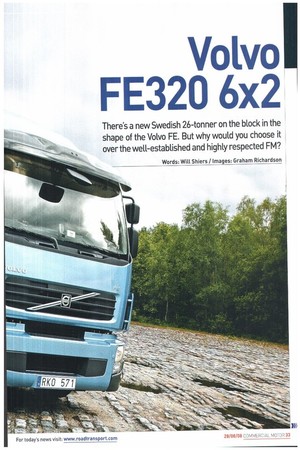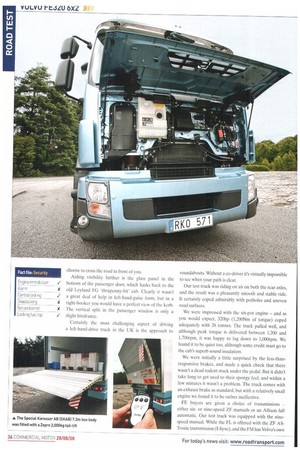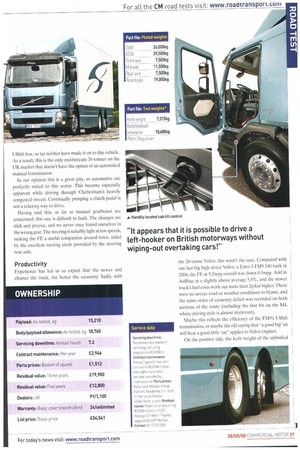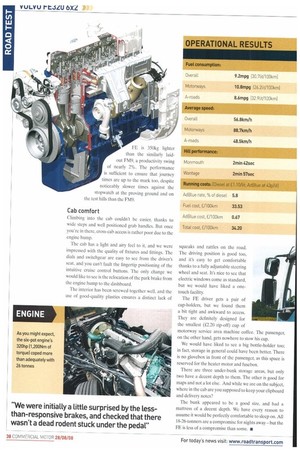Volvo FE320 6x2
Page 33

Page 34

Page 35

Page 36

Page 37

Page 38

If you've noticed an error in this article please click here to report it so we can fix it.
There's a new Swedish 26-tonner on the block in the shape of the Volvo FE. But why would you choose it over the well-established and highly respected FM?
Words: Wilt Shiers / Images: Graham Richardson Don't be co nf used by the Swedish number plates on this left-hand-drive Volvo FE, because this isn't one of those trucks that will never be available in the UK. The FE320 6x2 rigid is very much for sale in Blighty, and the foreign plates are only because Volvo doesn't have a right-hooker on its UK demo fleet.
The FE is offered with a choice of three cabs— the Short Day, Medium and Long Sleeper. All arc equipped with a six-cylinder 7.2-litre engine, with ratings of 240hp. 280hp and 320hp. Our test truck was the largest, most powerful offering.
Despite its fresh appearance, the FE uses the familiar Renault Premium cab. But the Swedes have done a fantastic job of disguising its heritage, and the FE shares the same family appearance as its bigger FM and FH siblings.
Apparently, Volvo has made just shy of 100 changes to the cab. While some of these, such as the new headlights and grille, are obvious, others are not — the strengthening of the cab to comply with stringent Swedish crash-testing, for example.
Being Swedish-sourced, the Volvo's body had also crossed the North Sea, but apart from the unfamiliar brand name of Special Karosser AB (with its memorable acronym) and its Zepro 2,000kg tail-lift, it's a relatively normal 25ft box.
It's a good-looking truck, and it attracted a number of positive comments from fellow drivers in the hourlong queue for fuel at Mem bury Services.
It also created plenty of attention on the road, with a number of stares from approaching truck drivers. But this might have been due to our relative inexperience at driving a left-hooker on the UK's roads, and our tendency to creep towards the white line!
The truck also attracted the unwanted attention of Vosa, which demanded that we pull over on the A40.
Its officers were finding it difficult to comprehend why the truck was wearing both Swedish registration plates and UK trade plates, and we spent several minutes on the hard shoulder explaining the situation.
On the road
We've had plenty of experience of driving lefthand-drive trucks on the Continent, but this was one of the few times that we'd driven one in the UK. It does take a while to get used to, and our lane positioning was a little imprecise for the first few miles.
The driver's mirror quickly becomes your best friend. When you are travelling down a narrow B-road and approaching another large vehicle, you rely on this to take you as close to the kerb as possible. Although the Volvo demo driver brought a spare mirror with him. we are pleased to report that it stayed in its box.
Visibility from the driver's seat is superb, thanks to large, wellpositioned mirrors. It appears that it is possible to drive a left-hooker on British motorways without wiping-out overtaking cars!
And we like the roof-mounted 'cleavage' mirror too, which is positioned at the far corner of the windscreen and gives a perfect overhead view of pedestrians who choose to cross the road in front of you.
Aiding visibility further is the glass panel in the bottom of the passenger door, which harks back to the old Leyland FG 'thrupenny-bit' cab. Clearly it wasn't a great deal of help in left-hand-guise form, but in a right-hooker you would have a perfect view of the kerb. The vertical split in the passenger window is only a slight hindrance.
Certainly the most challenging aspect of driving a left-hand-drive truck in the UK is the approach to roundabouts. Without a co-driver it's virtually impossible to see when your path is clear.
Our test truck was riding on air on both the rear axles, and the result was a pleasantly smooth and stable ride. It certainly coped admirably with potholes and uneven road surfaces.
We were impressed with the six-pot engine — and as you would expect, 320hp (1,200Nm of torque) coped adequately with 26 tonnes. The truck pulled well, and although peak torque is delivered between 1,200 and 1,700rpm, it was happy to lug down to 1,000rpm. We found it to be quiet too, although sonic credit must go to the cab's superb sound insulation.
We were initially a little surprised by the less-thanresponsive brakes, and made a quick check that there wasn't a dead rodent stuck under the pedal. But it didn't take long to get used to their spongy feel, and within a few minutes it wasn't a problem. The truck comes with an exhaust brake as standard, but with a relatively small engine we found it to be rather ineffective.
FE buyers are given a choice of transmissions — either sixor nine-speed ZF manuals or an Allison full automatic. Our test truck was equipped with the ninespeed manual. While the FL is offered with the ZF ASTronic transmission (I-Sync), and the FM has Volvo's own I-Shift box, so far neither have made it on to this vehicle. As a result, this is the only mainstream 26-tonner on the UK market that doesn't have the option of an automated manual transmission.
In our opinion this is a great pity, as automatics are perfectly suited to this sector. This became especially apparent while driving through Cheltenham's heavily congested streets. Continually pumping a clutch pedal is not a relaxing way to drive.
Having said this, as far as manual gearboxes arc concerned, this one is difficult to fault. The changes are slick and precise, and we never once found ourselves in the wrong gear. The steering is suitably light at low speeds, making the FE a useful companion around town, aided by the excellent turning circle provided by the steering rear axle.
Productivity
Experience has led us to expect that the newer and cleaner the truck, the better the economy. Sadly, with the 26-tonne Volvo, this wasn't the case. Compared with our last big high street Volvo, a Euro-3 FM9 340 back in 2004, the FE at 9.2mpg overall was down 0.5mpg. Add in AdBlue at a slightly above average 5.8%, and the newer truck's fuel costs work out more than 2p/km higher. There were no severe road or weather conditions to blame, and the same order of economy deficit was recorded on both sections of the route (including the first bit on the M4, where driving style is almost irrelevant).
Maybe this reflects the efficiency of the FM9's 1-Shift transmission, or maybe the old saying that "a good big `un will beat a good little 'tin" applies to Volvo engines.
On the positive side, the kerb weight of the unbodied FE is 350kg lighter than the similarly laidout FM9, a productivity swing of nearly 2%. The performance is sufficient to ensure that journey times are up to the mark too, despite noticeably slower times against the stopwatch at the proving ground and on the test hills than the FM9.
Cab comfort Climbing into the cab couldn't be easier, thanks to wide steps and well positioned grab handles. But once you're in there, cross-cab access is rather poor due to the engine hump.
The cab has a light and airy feel to it, and we were impressed with the quality of fixtures and fittings. The dials and switchgear are easy to see from the driver's seat, and you can't fault the fingertip positioning of the intuitive cruise control buttons. The only change we would like to see is the relocation of the park brake from the engine hump to the dashboard.
The interior has been screwed together well. and the use of good-quality plastics ensures a distinct lack of squeaks and rattles on the road. The driving position is good too, and it's easy to get comfortable thanks to a fully adjustable steering wheel and seat. It's nice to see that electric windows come as standard, but we would have liked a onetouch facility.
The FE driver gets a pair of cup-holders, but we found them a bit tight and awkward to access. They are definitely designed for the smallest (£2.20 rip-off) cup of motorway service area machine coffee. The passenger, on the other hand, gets nowhere to stow his cup.
We would have liked to see a big bottle-holder too; in fact, storage in general could have been better. There is no glovebox in front of the passenger, as this space is reserved for the heater motor and fusebox.
There are three under-bunk storage areas, but only two have a decent depth to them. The other is good for maps and not a lot else. And while we are on the subject, where in the cab are you supposed to keep your clipboard and delivery notes?
The bunk appeared to be a good size, and had a mattress of a decent depth. We have every reason to assume it would be perfectly comfortable to sleep on. All 18-26-tormers are a compromise for nights away — but the FE is less of a compromise than some. •




































































































































































